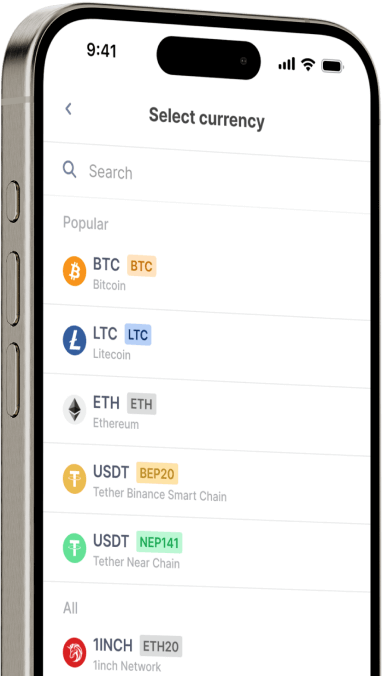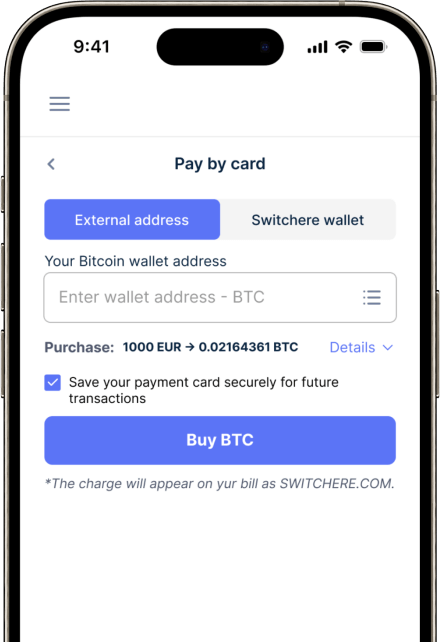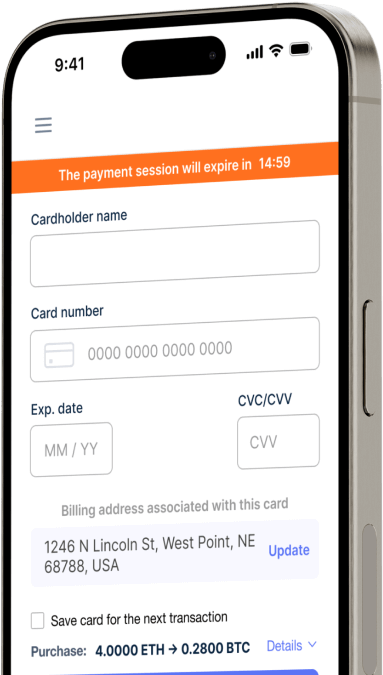Convert
Canadian Dollar (CAD) to Wrapped Bitcoin (WBTC) Instantly
Purchase Wrapped Bitcoin (WBTC) with Canadian Dollar (CAD) easily at Switchere and benefit from fast, secure transactions.
About
Wrapped Bitcoin (WBTC)
Wrapped Bitcoin (WBTC) is an ERC-20 token on the Ethereum blockchain, designed to represent Bitcoin (BTC) on a 1:1 basis, thereby bringing Bitcoin's immense liquidity and value into the decentralized finance (DeFi) ecosystem. Its primary purpose is to enhance interoperability, allowing Bitcoin holders to utilize their digital assets within Ethereum's burgeoning landscape of smart contracts and DeFi applications without selling their BTC. This tokenization of Bitcoin effectively bridges two major blockchain networks, addressing a significant challenge in the crypto space.
The core mechanism behind WBTC involves a federation of custodians and merchants who mint new WBTC by locking up an equivalent amount of actual Bitcoin and burn WBTC to redeem the underlying BTC. This process is transparently verifiable on-chain through a Proof of Reserve system, ensuring cryptographic security and maintaining the crucial 1:1 peg. As an ERC-20 token, WBTC seamlessly integrates with Ethereum's infrastructure, including decentralized exchanges (DEXs), lending protocols, and yield farming platforms, expanding the utility of the original digital asset.
The main function of the WBTC token is to serve as a highly liquid, Bitcoin-backed collateral and trading pair within DeFi. Holders can use WBTC for lending, borrowing, providing liquidity to earn fees, or participating in various yield-generating strategies, all while retaining exposure to Bitcoin's price movements. WBTC has become a foundational element in the DeFi space, acting as a key enabler for cross-chain liquidity and a testament to the innovative potential of tokenization within blockchain technology, significantly expanding the on-chain utility of Bitcoin on other networks.
Buy Other 150+ Cryptocurrencies for Canadian Dollar (CAD)
Other Coins for Canadian Dollar (CAD)
-
CAD to ZRX
-
CAD to 1INCH
-
CAD to AAVE
-
CAD to ACH
-
CAD to ALGO
-
CAD to TLM
-
CAD to ANKR
-
CAD to APE
-
CAD to NFT
-
CAD to API3
-
CAD to APT
-
CAD to ARPA
-
CAD to AUDIO
-
CAD to AVAX
-
CAD to AVAX
-
CAD to AXS
-
CAD to BADGER
-
CAD to BAL
-
CAD to BNT
-
CAD to BAT
-
CAD to BNB
-
CAD to BSW
-
CAD to BSV
-
CAD to BLUR
-
CAD to BONE
-
CAD to CTSI
-
CAD to CELR
-
CAD to CELO
-
CAD to CEL
-
CAD to LINK
-
CAD to CHZ
-
CAD to CHR
-
CAD to C98
-
CAD to COMP
-
CAD to CFX
-
CAD to PEOPLE
-
CAD to CVX
-
CAD to ATOM
-
CAD to CTC
-
CAD to CRV
-
CAD to DAI
-
CAD to DASH
-
CAD to MANA
-
CAD to DENT
-
CAD to DGB
-
CAD to DYDX
-
CAD to XEC
-
CAD to EOS
-
CAD to ETC
-
CAD to ENS
-
CAD to ETHW
-
CAD to FET
-
CAD to FIL
-
CAD to FLOKI
-
CAD to GALA
-
CAD to GNO
-
CAD to ONE
-
CAD to HBAR
-
CAD to HOT
-
CAD to HOOK
-
CAD to ICX
-
CAD to ILV
-
CAD to IMX
-
CAD to INJ
-
CAD to ICP
-
CAD to IOST
-
CAD to IOTX
-
CAD to JASMY
-
CAD to JST
-
CAD to KAVA
-
CAD to KCS
-
CAD to KSM
-
CAD to KNC
-
CAD to LDO
-
CAD to LQTY
-
CAD to LPT
-
CAD to LOOKS
-
CAD to LRC
-
CAD to LUNA
-
CAD to MKR
-
CAD to MASK
-
CAD to EGLD
-
CAD to ALICE
-
CAD to NEAR
-
CAD to XEM
-
CAD to NEXO
-
CAD to NOT
-
CAD to NMR
-
CAD to OKB
-
CAD to OMG
-
CAD to ONT
-
CAD to EDU
-
CAD to OP
-
CAD to OGN
-
CAD to CAKE
-
CAD to PAXG
-
CAD to PENDLE
-
CAD to DOT
-
CAD to POL
-
CAD to QTUM
-
CAD to QNT
-
CAD to RDNT
-
CAD to XRD
-
CAD to RVN
-
CAD to REN
-
CAD to RSR
-
CAD to RLC
-
CAD to RPL
-
CAD to SFP
-
CAD to SHIB
-
CAD to SKL
-
CAD to SXP
-
CAD to STND
-
CAD to STG
-
CAD to XLM
-
CAD to GMT
-
CAD to STORJ
-
CAD to STMX
-
CAD to SUSHI
-
CAD to SNX
-
CAD to USDT (Polygon)
-
CAD to USDT (AVAC)
-
CAD to USDT (BEP20)
-
CAD to USDT (ERC20)
-
CAD to USDT (SPL)
-
CAD to USDT (NEP141)
-
CAD to USDT (FA2)
-
CAD to USDT (TRC20)
-
CAD to USDT (JETTON)
-
CAD to XTZ
-
CAD to GRT
-
CAD to SAND
-
CAD to TFUEL
-
CAD to THETA
-
CAD to RUNE
-
CAD to TON
-
CAD to TUSD (BEP20)
-
CAD to TUSD (TRC20)
-
CAD to TWT
-
CAD to UOS
-
CAD to UMA
-
CAD to UNI
-
CAD to USDC (Polygon)
-
CAD to USDC (SPL)
-
CAD to USDC (OP)
-
CAD to USDC (BEP20)
-
CAD to USDC (AVAC)
-
CAD to USDC (ARB)
-
CAD to USDC (ERC20)
-
CAD to VET
-
CAD to VRA
-
CAD to WAXP
-
CAD to WOO
-
CAD to WLD
-
CAD to WBTC
-
CAD to WMINIMA
-
CAD to XDC
-
CAD to YFI
-
CAD to YGG
-
CAD to ZIL
How to Buy Wrapped Bitcoin (WBTC)
Frequently Asked Questions
-
What is Wrapped Bitcoin (WBTC) and how does it differ from BTC when buying with Canadian Dollars?
Wrapped Bitcoin (WBTC) is an ERC-20 token on the Ethereum blockchain, with each token backed 1:1 by Bitcoin (BTC) held by a custodian. When you buy WBTC with CAD, you are acquiring a representation of Bitcoin that can interact with Ethereum's DeFi ecosystem. Unlike a standard CAD-to-BTC transaction which happens on the Bitcoin network, a CAD-to-WBTC purchase gives you an asset compatible with the Ethereum Virtual Machine (EVM), enabling its use in smart contracts, lending protocols, and liquidity pools.
-
Why would an investor use CAD to acquire WBTC instead of native Bitcoin?
The primary motivation for acquiring WBTC is to deploy Bitcoin's value within the decentralized finance (DeFi) space on Ethereum. While native BTC acts as a store of value, WBTC can be actively used as collateral in lending protocols like Aave or Compound, provided as liquidity to earn trading fees, or utilized in various yield farming strategies. This unlocks utility for a digital asset that would otherwise be passive.
-
How do transaction fees for WBTC differ from native BTC after an initial CAD purchase?
After acquiring WBTC, any subsequent transfer or smart contract interaction occurs on the Ethereum network and requires 'gas fees' paid in ETH. These fees can fluctuate significantly based on network congestion and are measured in Gwei. This is distinct from native Bitcoin transactions, which require a fee paid to miners on the Bitcoin blockchain. Understanding the dynamics of Ethereum gas fees is crucial for managing WBTC effectively.
-
What are the primary methods for a Canadian resident to convert CAD into WBTC?
The most common pathway involves using a FINTRAC-regulated Canadian cryptocurrency exchange to perform a fiat on-ramp. Users typically deposit Canadian Dollars via Interac e-Transfer or Electronic Funds Transfer (EFT) to buy a base cryptocurrency like Ethereum (ETH) or a stablecoin like USDC. Subsequently, they transfer this asset to a personal digital wallet and use a decentralized exchange (DEX) like Uniswap to swap it for WBTC.
-
What security practices are essential when holding WBTC purchased with CAD?
Since WBTC is an ERC-20 token, it must be stored in an Ethereum-compatible digital wallet, not a native Bitcoin wallet. Best practices include using a hardware wallet (e.g., Ledger or Trezor) for secure offline storage of your private keys. Always be cautious of smart contract risks associated with the DeFi protocols where you might deploy your WBTC and verify contract addresses before interacting with them.
-
Are direct CAD/WBTC trading pairs commonly available on Canadian exchanges?
Direct CAD-to-WBTC order books are not common on most centralized Canadian cryptocurrency exchanges. The standard procedure is a two-step process: first, converting CAD to a highly liquid asset like ETH, and second, swapping that asset for WBTC on a decentralized exchange. This route leverages the deep liquidity pools available for WBTC within the Ethereum ecosystem rather than relying on a direct fiat gateway.




